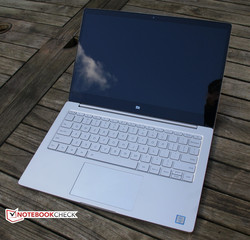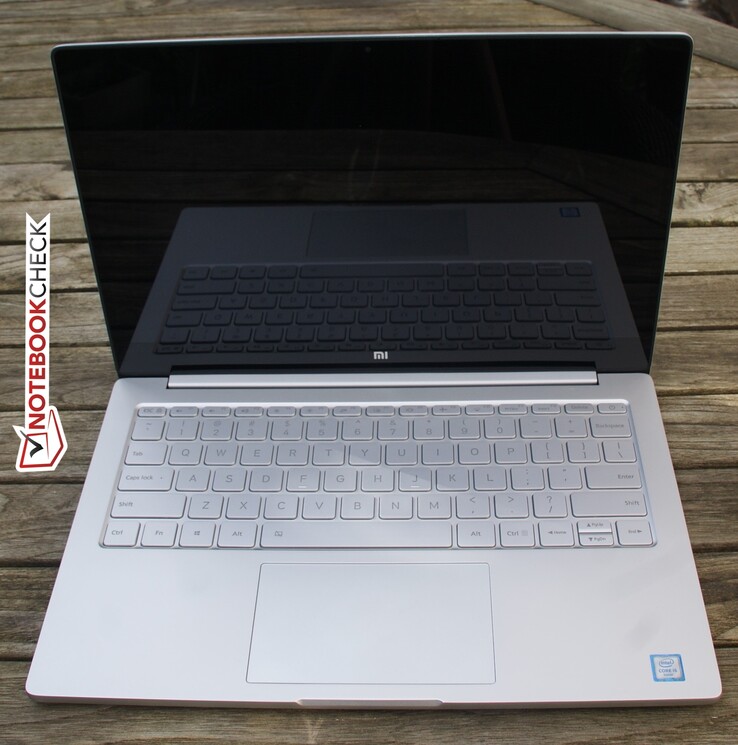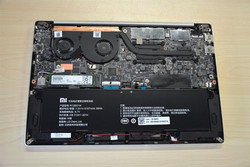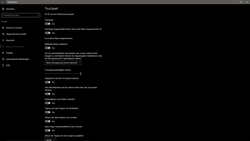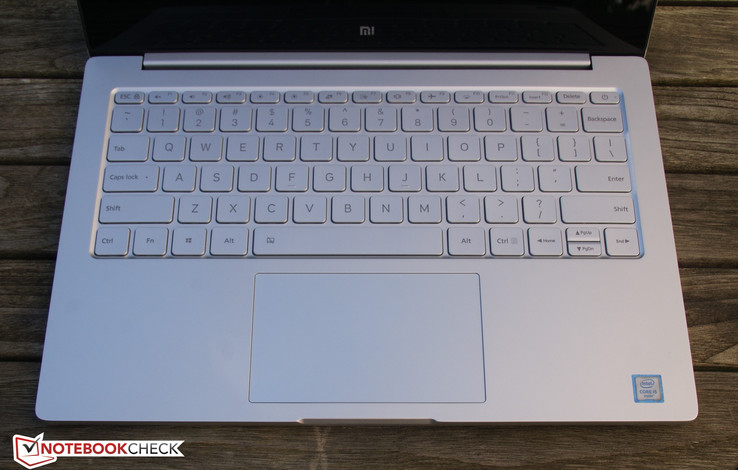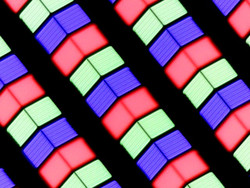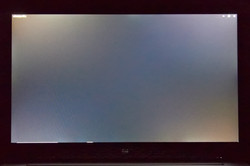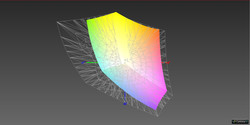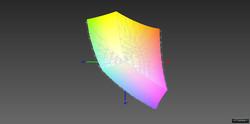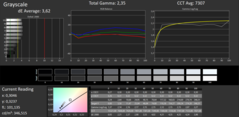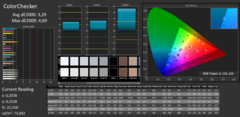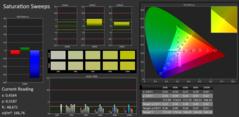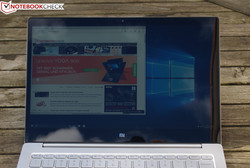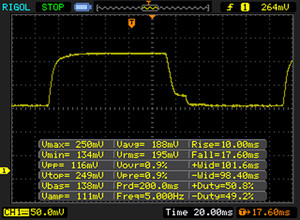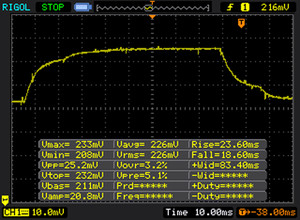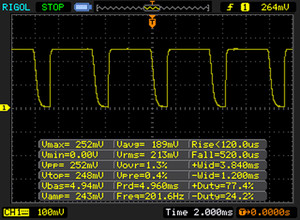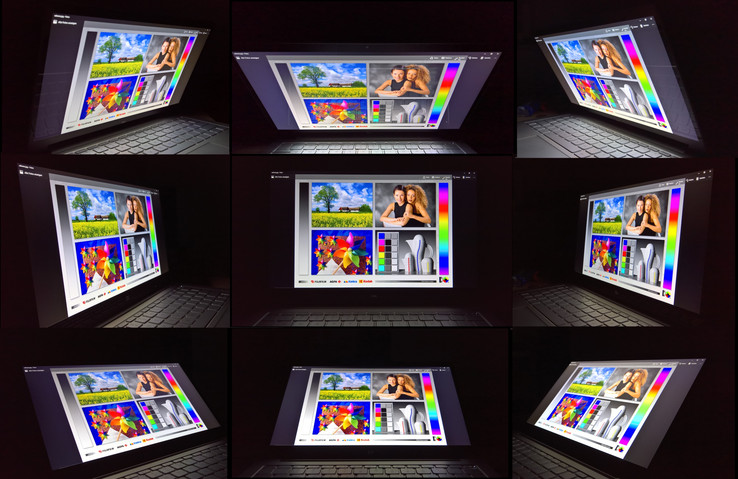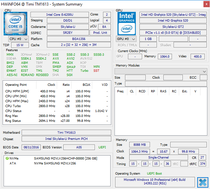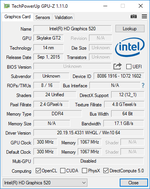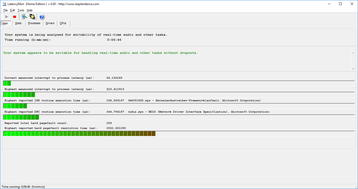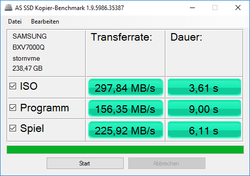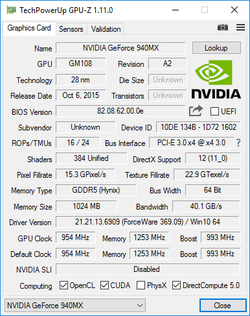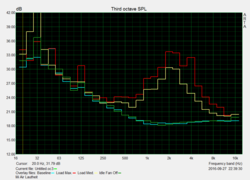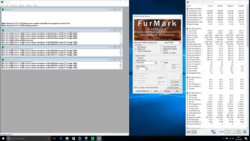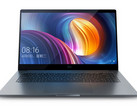Xiaomi Mi Air (13.3-inch) Notebook Review

For the original German review, see here.
The fact that a new player appears on the laptop market does have scarcity value. After all, the PC market is shrinking overall, meaning that low sales are concentrated over fewer and fewer manufacturers - even now an acquisition of Fujitsu's PC operation by market leader Lenovo is under discussion.
Market entries by Huawei (with the MateBook) and Xiaomi are greatly appreciated even though they are acting contrary to the trend. Also, this new participant can get the market moving by increasing the competition. However, one must say that Xiaomi and Huawei chose specific branches of the PC market for their entries. Huawei chose the 2-in-1 branch and Xiaomi chose the sector for slim Ultrabooks. These market fields can probably offer the best growth opportunities.
Let's focus on the Xiaomi device: Xiaomi is a very successful manufacturer in the smartphone market which is, however, regionally concentrated in China. Xiaomi's business model consists of offering as good devices as possible at low prices to undercut the competition, therefore low or even no profit from hardware purchases is accepted. This strategy showed great success in the smartphone market, at least until 2015, when Xiaomi weakened a bit. Now that success could be repeated in the PC market with the here reviewed Mi Notebook Air.
As we proverbially look upon Xiaomi's first work, there is, of course, no previous device to compare the Mi Notebook Air 13.3 with. However, the laptop does have a smaller sibling in the form of the Mi Notebook Air 12.5. This one is equipped with Y-class CPUs (TDP 4.5 W). The here tested 13.3-inch model in comparison has the stronger processors of the U-class (TDP 15 W). Neither device is officially available in Germany, as with the smartphones Xiaomi focuses on the Chinese home market. It is possible to import them though (including all risks involved as the Mi Air does not have a CE-label, see also our article with the topic Import from China), for example via the importer Trading Shenzhen. From there we also ordered our test device which is equivalent to the only configuration of the Mi Notebook Air 13.3 available to order with i5, 256 GB SSD, and 8 GB RAM. The whole thing can be purchased for 867 Euros (~$942, without customs/ import costs or shipping!).
Case
"Plain." This word describes the design of the Mi Notebook Air best. To create a neat design the manufacturer even goes as far as to do without its logo on the display cover. Only a small, silver Mi-logo is placed underneath the display. Also, the labeling of interfaces is given up on. Apart from that, the design is quite appropriate but also a little unoriginal. You do not have to be an expert to recognize similarities to Apple's MacBook design; Xiaomi does not take any big risks here.
The entire case is, with exception of the relatively thin display frame, silver-colored. Together with the touchpad it is the only part of the case that is not made out of aluminum because a glass pane is located in front of the display. In terms of stability the case can definitely convince, it is built in a unibody design. Neither the wrist rest, keyboard area nor the bottom can be considerably pushed in. The relatively thin display cover can be warped a little by a single twisting motion; nevertheless, the stability in this area is overall also on a very high level. Even looking at the haptics there is nothing to declare, the device feels like it is high quality.
Regarding the hinge, the design is obvious: It has a single hinge that takes over nearly the whole case width, exactly like the Apple MacBook. The hinge allows a maximum opening angle of approx. 130 ° which is a little restrictive in comparison to several other notebooks (e.g. Dell Latitudes, Lenovo ThinkPads). Besides that, the Xiaomi hinge is adjusted well and the display cover can be opened with one hand. In bumpy environments, for example on a train, the display shakes a little bit. Overall, the hinge does have the display cover under control though.
The Mi Notebook Air 13 is a comparatively compact device, thanks to the slim display frames. It is only slightly bigger than the more compact XPS 13 that has even smaller display frames - therefore the camera of the Xiaomi device is not pointed to look up your nose. The MacBook 12 is even more compact and lighter but at the same time offers weaker hardware, here the 12.5-inch version of the Mi Notebook Air could more likely be a good competitor.
Xiaomi delivers a solid case that does not have to hide from its competition. There is not really anything to criticize. It would be nice to be able to open the display further and the display frames could be smaller but that is no real criticism, more an "it could still be better" comment.
Connectivity
The Mi Notebook Air not only has a simple design, it also has a simple connectivity. The device's equipment is kept to the absolute minimum whereas it could, of course, be even more radical. Like most retail Ultrabooks, the Mi Notebook Air does not have an Ethernet port. We also sadly miss an SD-card reader, unlike Ethernet this is something the competition is able to provide.
There is nothing negative to say about the port placement. They are all placed on both sides of the rear part which won't cause any problems in operation of the mouse, no matter if the user is right- or left-handed. The USB ports could be a slight problem: It might be difficult to connect a large USB-device when using the HDMI-port to charge the device. Not really an issue though.
The device can be charged via USB type-C. The USB type-C port is also supposed to be used to connect monitors.
Communication
The wireless communication module in the Mi Notebook Air is made by Intel. The Intel 8260 AC is one of the most installed WLAN-cards when it comes to more expensive notebooks and should be familiar to many of our readers. The card is installed here with two antennas. A benchmark comparison shows that the 8260 delivers a good performance, there is nothing to declare. No anomalies were found in terms of practical use, the connection was stable throughout the entire test.
As already mentioned, the device does not have Ethernet.
| Networking | |
| iperf Server (receive) TCP 1 m | |
| Xiaomi Mi Notebook Air 13.3 2016 | |
| Acer TravelMate X3 X349-M-7261 (jseb) | |
| Medion Akoya S3409-MD60234 (jseb) | |
| iperf Client (transmit) TCP 1 m | |
| Acer TravelMate X3 X349-M-7261 (jseb) | |
| Xiaomi Mi Notebook Air 13.3 2016 | |
| Medion Akoya S3409-MD60234 (jseb) | |
Accessories
The laptop comes with hardly any accessories except for a standard Chinese power cable. An adapter is attached. For an additional charge, Trading Shenzhen puts in a USB stick containing a German version of Windows 10 Home that can be installed as the operating system, which is, of course, in Chinese.
There are no docking solutions or anything similar for the Mi Notebook Air, if at all via USB. It is questionable whether such is really necessary for personal devices. Devices like the XPS 13 do have compatible docks though thanks to Thunderbolt 3 connections. Not a huge deficit but it would be nicer, of course, with a Thunderbolt 3 connection.
Maintenance
The case of the Mi Notebook Air should be easy to open. However, Xiaomi uses Torx screws instead of the more common Phillips screws. This might cause a problem and it did for us as we were not able to open the test device. In this regard, other testers already took a closer look into the Mi Notebook Air. Once the base plate is removed, access is given to the battery, fans (easy cleaning possible) as well as to the SSD. The M.2-SSD can easily be replaced with a larger one. On top of that the Mi Notebook Air offers a second free M.2-port to retrofit a second M.2-2280 SSD. Memory and CPU are soldered on and therefore only exchangeable with a new motherboard.
Warranty
Since the Mi Notebook Air is classed as an import device in Germany, the warranty is not a simple issue. Nevertheless, Trading Shenzhen does offer a 12-month warranty on its own. If any malfunctions occur during that time you can at least contact them.
We should also mention that the Xiaomi Mi Notebook Air does not have a CE-label. The potential consequences are summed up in this detailed article for anyone who wants to know more.
Please see our Guarantees, Return Policies & Warranties FAQ too for country-specific information.
Input Devices
Keyboard
Xiaomi installs a six-row keyboard in the chiclet style. The keys have a silver color and smooth surface, the lettering is black. Most of the keys have a default size, regarding the whole keyboard it is slightly less wide than the general standard. This means that the keys on the right side are minimally smaller, which does not really stand out. The vertical arrow keys are somewhat annoying as they are squeezed together.
The typing feel of the keys is quite nice. Typical for Ultrabooks, the key drop is relatively low; the keystroke is more crisp than soft. The keyboard is not loud and does not yield due to the unibody case.
The keyboard has a backlight with only one brightness level. It automatically turns off when the device is not being used, which comes in handy. Tapping a key turns it back on.
One further point to be mentioned: the keyboard is a US-keyboard in the QWERTY-layout. At the moment, the Mi Notebook Air is not available with a German QWERTZ-layout which might be a negative point to some European buyers.
Touchpad
Again, Xiaomi is oriented towards Apple's design. The touchpad is a ClickPad, meaning the mouse buttons are integrated into the touch area. The ClickPad is made out of glass and has an excellent gliding quality.
Generally speaking, the touchpad works really well. With excellent precision and response behavior, multitouch gestures are registered more reliably in comparison to many other Windows touchpads. A reason for that could be the fact that the touchpad is a Microsoft Precision Touchpad. Precision touchpads are supposed to be particularly responsive and should be easy to operate just like a modern multitouch display – and that is indeed the case here.
The click mechanism itself convinces as well. ClickPads are often wobbly in cheaper devices and sound hollow. Not here. However, the precision of dedicated keys is not achieved to the fullest.
One problem that occurred during the test: The right-hand click did not work on the bottom right side of the screen. We assume a driver failure might be the reason for that. The right-hand click using two fingers worked perfectly.
Display
The Mi Notebook Air 13 is available with one display version only. A 13.3-inch Full HD IPS panel is installed. This LC-display with LED-light is a Samsung product with the model number LTN133HL09-M01. Since it comes from Samsung it is probably a PLS-type panel. Although the panel itself is matte, the display is glossy due to an edge-to-edge glass plate. Xiaomi does not offer a touch option.
The display's brightness is indicated at 300 cd/m². Not only does the display reach this figure, but it also exceeds the maximum of 347 cd/m² significantly. The average rate lies at around 333.7 cd/m² - also much higher than 300 cd/m². However, the brightness is not evenly distributed: The lower section seems to be darker and the display barely reaches 300 cd/m². But, this did not seem striking in the subjective test. Concerning backlight bleeding, the display does show a little bit of bleeding. The attached picture shows the effect in a slightly exaggerated form; the bleeding is actually not noticeable, not even on dark display content. The display only has a low PMW-frequency (50 Hz) when the brightness level is reduced to 30% or less. Even with a preferably higher rate here, this should not be an issue for the majority of users.
A direct comparison to the competition does not turn out badly for the display. It ranges on the same level as the very good Full HD IPS display that is installed in the XPS 13. The QHD display (2560x1600) of the MacBook Pro 13 also has a quite similar quality.
| |||||||||||||||||||||||||
Brightness Distribution: 80 %
Center on Battery: 347 cd/m²
Contrast: 1285:1 (Black: 0.27 cd/m²)
ΔE ColorChecker Calman: 3.29 | ∀{0.5-29.43 Ø4.77}
ΔE Greyscale Calman: 3.62 | ∀{0.09-98 Ø5}
95% sRGB (Argyll 1.6.3 3D)
62% AdobeRGB 1998 (Argyll 1.6.3 3D)
67.8% AdobeRGB 1998 (Argyll 3D)
95.5% sRGB (Argyll 3D)
66% Display P3 (Argyll 3D)
Gamma: 2.23
CCT: 7307 K
| Xiaomi Mi Notebook Air 13.3 2016 Samsung LTN133HL09-M01, , 1920x1080, 13.3" | Dell XPS 13 2016 9350 (FHD, i7-6560U) Sharp SHP1449 LQ133M1, , 1920x1080, 13.3" | Dell XPS 13 9360 QHD+ i5 Sharp SHP144A, , 3200x1800, 13.3" | Apple MacBook Air 13 inch 2015-03 Apple APP9CF0, , 1440x900, 13.3" | Apple MacBook Pro Retina 13 inch 2015-03 APPA02A, , 2560x1600, 13.3" | Lenovo IdeaPad 710S-13ISK 80SW0031US Sharp SHP 1447 / LQ133M1JW15, , 1920x1080, 13.3" | |
|---|---|---|---|---|---|---|
| Display | -16% | -3% | -38% | 0% | 1% | |
| Display P3 Coverage (%) | 66 | 54.8 -17% | 64.6 -2% | 40.1 -39% | 65.9 0% | 65.9 0% |
| sRGB Coverage (%) | 95.5 | 82.3 -14% | 91.6 -4% | 59.8 -37% | 97 2% | 97 2% |
| AdobeRGB 1998 Coverage (%) | 67.8 | 56.6 -17% | 66.5 -2% | 41.51 -39% | 67.4 -1% | 68 0% |
| Response Times | 11% | 11% | -39% | |||
| Response Time Grey 50% / Grey 80% * (ms) | 49 ? | 42.8 ? 13% | 31 ? 37% | 56 ? -14% | ||
| Response Time Black / White * (ms) | 27 ? | 24.8 ? 8% | 31.2 ? -16% | 44 ? -63% | ||
| PWM Frequency (Hz) | 50 ? | 219.3 ? | ||||
| Screen | 1% | -4% | -25% | 8% | -37% | |
| Brightness middle (cd/m²) | 347 | 385 11% | 444 28% | 329 -5% | 361 4% | 349 1% |
| Brightness (cd/m²) | 334 | 350 5% | 393 18% | 310 -7% | 342 2% | 339 1% |
| Brightness Distribution (%) | 80 | 86 8% | 82 3% | 82 3% | 81 1% | 88 10% |
| Black Level * (cd/m²) | 0.27 | 0.17 37% | 0.33 -22% | 0.405 -50% | 0.361 -34% | 0.393 -46% |
| Contrast (:1) | 1285 | 2265 76% | 1345 5% | 812 -37% | 1000 -22% | 888 -31% |
| Colorchecker dE 2000 * | 3.29 | 4.17 -27% | 4 -22% | 3.96 -20% | 1.82 45% | 6.85 -108% |
| Colorchecker dE 2000 max. * | 4.69 | 7.61 -62% | 7.7 -64% | 7.51 -60% | 3.26 30% | 10.27 -119% |
| Greyscale dE 2000 * | 3.62 | 5.39 -49% | 2.83 22% | 3.51 3% | 1.8 50% | 6.43 -78% |
| Gamma | 2.23 99% | 2.12 104% | 2.05 107% | 3.83 57% | 2.49 88% | 1.83 120% |
| CCT | 7307 89% | 7404 88% | 6963 93% | 6711 97% | 6417 101% | 7820 83% |
| Color Space (Percent of AdobeRGB 1998) (%) | 62 | 62.7 1% | 59.3 -4% | 38.4 -38% | 61.9 0% | 61.9 0% |
| Color Space (Percent of sRGB) (%) | 95 | 99.8 5% | 91.4 -4% | 59.8 -37% | 96.9 2% | 97.3 2% |
| Total Average (Program / Settings) | -1% /
-1% | 1% /
-2% | -32% /
-28% | 4% /
6% | -25% /
-30% |
* ... smaller is better
Regarded subjectively, the display is excellent. The colors appear very vivid and black nearly seems like a real black. This impression was confirmed by the measured contrast of 1285:1. The installed Samsung panel definitely competes in a high league. Only an OLED display would be substantially better. The focus is good as well. Avoiding any problems with scaling, the size is ideal for Full HD even if it could be sharper with a higher resolution.
The display's good performance is complemented by good coverage of the color space. Semi-professional image editing is possible thanks to a 95% sRGB coverage.
Due to the glossy display surface, outdoor usage is limited. Thanks to the relatively high brightness, use in the shade or on cloudy days is no problem if the reflections can be ignored by the user. Only in direct sunlight is it really hard to recognize anything on the display. A matte display, like as installed in Dell's XPS 13 with Full HD, would be desirable.
Display Response Times
| ↔ Response Time Black to White | ||
|---|---|---|
| 27 ms ... rise ↗ and fall ↘ combined | ↗ 8 ms rise | |
| ↘ 19 ms fall | ||
| The screen shows relatively slow response rates in our tests and may be too slow for gamers. In comparison, all tested devices range from 0.1 (minimum) to 240 (maximum) ms. » 67 % of all devices are better. This means that the measured response time is worse than the average of all tested devices (20.2 ms). | ||
| ↔ Response Time 50% Grey to 80% Grey | ||
| 49 ms ... rise ↗ and fall ↘ combined | ↗ 20 ms rise | |
| ↘ 29 ms fall | ||
| The screen shows slow response rates in our tests and will be unsatisfactory for gamers. In comparison, all tested devices range from 0.165 (minimum) to 636 (maximum) ms. » 84 % of all devices are better. This means that the measured response time is worse than the average of all tested devices (31.6 ms). | ||
Screen Flickering / PWM (Pulse-Width Modulation)
| Screen flickering / PWM detected | 50 Hz | ≤ 30 % brightness setting | |
The display backlight flickers at 50 Hz (worst case, e.g., utilizing PWM) Flickering detected at a brightness setting of 30 % and below. There should be no flickering or PWM above this brightness setting. The frequency of 50 Hz is very low, so the flickering may cause eyestrain and headaches after extended use. In comparison: 53 % of all tested devices do not use PWM to dim the display. If PWM was detected, an average of 8083 (minimum: 5 - maximum: 343500) Hz was measured. | |||
The viewing angles are outstanding and meet the highest standard found in the IPS display range. Thankfully, colors do not invert at all in contrast to cheaper TN displays. A reduced brightness that occurs on some IPS displays is also hardly noticeable. The greatest limitation is the display surface, as it reflects at extreme viewing angles.
Performance
Due to the fact that the Mi Notebook Air is the only 13.3-inch model at the moment there is not much to say about alternative versions. The Mi Notebook Air has a Core-i5 processor from the Skylake generation, the core i5-6200U. Unfortunately, the change to Kaby Lake is just happening right now. If Xiaomi had waited a month or two it probably would have been able to install Kaby Lake CPUs.
A special feature is the installed dedicated GPU. Most subnotebooks just have an Intel iGPU like the Intel HD 520, which is also integrated into the Mi Notebook Air. However, Xiaomi installs the Nvidia GeForce 940MX on top of that.
Xiaomi installs 8 GB DDR4-RAM in all Mi Notebook Air models as standard. It is good that a 4 GB option does not exist anymore since the RAM is soldered and not upgradable. In this regard, it is kind of disappointing that there is no 16 GB version available either. Interestingly, the RAM runs in single-channel mode. This is not to be seen as a huge drawback though. The iGPU especially benefits from dual-channel mode but that is of minor importance as a dGPU is installed as well.
Processor
In the ULV-class, the i5-6200U core is the basic unit. The CPU is soldered onto the motherboard and therefore cannot be upgraded (like all laptop CPUs since Broadwell), has a TDP of 15 W and it is a dual-core CPU. As an i5-model the processor has Hyper-Threading and Turbo boost functionality.
The Mi Notebook Air gets very good results in the Cinebench test. Xiaomi obviously optimized the cooling system very well, throughout the entire test the maximum Turbo boost of 2.7 GHz (in the multicore test) can be easily maintained. The Mi Notebook Air is positioned in front of the T460s (i5-model) which can be used as a reference as the TDP is raised to 27 W. In battery mode, the Mi Notebook Air can also reach its full processing power.
| Cinebench R15 | |
| CPU Single 64Bit | |
| Lenovo ThinkPad T460s 20FA003FPB | |
| Xiaomi Mi Notebook Air 13.3 2016 | |
| Dell XPS 13-9350 | |
| Lenovo ThinkPad T460s-20F9003SGE | |
| Apple MacBook Air 13 inch 2015-03 | |
| Lenovo IdeaPad 710S-13ISK 80SW0031US | |
| CPU Multi 64Bit | |
| Lenovo ThinkPad T460s 20FA003FPB | |
| Apple MacBook Air 13 inch 2015-03 | |
| Xiaomi Mi Notebook Air 13.3 2016 | |
| Lenovo ThinkPad T460s-20F9003SGE | |
| Dell XPS 13-9350 | |
| Lenovo IdeaPad 710S-13ISK 80SW0031US | |
System Performance
There is nothing to criticize concerning the system performance. An interaction of 8 GB RAM, PCIe-SSD and the i5-processor leads to an always smoothly running system; waiting periods basically don't exist. The system does not need a long time to boot up; the results of the PCMark 8 test confirm the subjective impression.
| PCMark 8 Home Score Accelerated v2 | 3144 points | |
| PCMark 8 Work Score Accelerated v2 | 4274 points | |
Help | ||
Storage Device
Xiaomi installs a Samsung SSD, the PM951 to be exact. It is an OEM NVMe PCIe SSD by Samsung. The PM951 is obsolete though and the new PM961 is already on the market. Furthermore, being a PM-model, the PCIe-SSD is a slow unit; the fastest OEM PCIe SSDs have the letters SM in the name – private customer offshoots are models like the 950 Pro or now the 960 Pro. As expected, the PM951 performs well in the benchmarks. The Toshiba NVMe SSD in the new Kaby Lake XPS 13 is more or less at the same level.
| Xiaomi Mi Notebook Air 13.3 2016 Samsung PM951 NVMe MZVLV256 | Dell XPS 13 9360 QHD+ i5 Toshiba NVMe THNSN5256GPUK | Lenovo Yoga 900-13ISK 80MK Samsung SSD PM871 MZNLN512HCJH | Lenovo ThinkPad T460s-20F9003SGE Samsung CM871 MZ7LF192HCGS | Lenovo IdeaPad 710S-13ISK 80SW0031US Samsung MZNLN128HCGR-000L2 | |
|---|---|---|---|---|---|
| CrystalDiskMark 3.0 | -4% | -28% | -74% | -38% | |
| Read Seq (MB/s) | 1209 | 1168 -3% | 514 -57% | 446.5 -63% | 524 -57% |
| Write Seq (MB/s) | 314 | 329 5% | 459.5 46% | 171.1 -46% | 157.5 -50% |
| Read 512 (MB/s) | 1015 | 413.4 | 259.2 | 398.9 | |
| Write 512 (MB/s) | 307 | 424.5 | 167.2 | 157.7 | |
| Read 4k (MB/s) | 43.4 | 33 -24% | 36.34 -16% | 5.78 -87% | 36.57 -16% |
| Write 4k (MB/s) | 153.4 | 132 -14% | 100.1 -35% | 35.47 -77% | 99.4 -35% |
| Read 4k QD32 (MB/s) | 487.6 | 525 8% | 313.8 -36% | 94.9 -81% | 397.5 -18% |
| Write 4k QD32 (MB/s) | 312.2 | 325 4% | 96.8 -69% | 36.43 -88% | 157 -50% |
Graphics Card
An Nvidia GeForce 940MX is installed into the Mi Notebook Air. As already mentioned, it is unusual for a subnotebook to be equipped with a dedicated GPU. On top of that, the 940MX is not a bad GPU either: probably not enough for serious gamers but definitely with enough power for casual gamers. Especially because Xiaomi does things in style unlike many other manufacturers. The 940MX is installed with GDDR5 storage, not GDDR3. Frequently, the 940MX is installed as a DDR3 model even though the latest innovation is the GDDR5 storage in comparison to the older GeForce 940M.
In the benchmarks, the Mi Notebook Air is positioned just behind the Surface Book with dGPU – logical, as a very similar GPU is installed in this model. Devices equipped with Intel GPUs, regardless if Iris- or Intel HD GPU, can be clearly left behind. The full performance of the GPU is available in battery operation, too.
| 3DMark 11 Performance | 2578 points | |
| 3DMark Cloud Gate Standard Score | 7168 points | |
| 3DMark Fire Strike Score | 1832 points | |
Help | ||
Gaming Performance
As previously mentioned, the GeForce 940MX works well for casual gamers and therefore the Xiaomi Mi Notebook Air does, too. Current titles are well playable in reduced details; older games can be played in high or up to maximum level of details which is indeed a unique selling point compared to many competitors. The XPS 13 is at most available with Intel Iris GPUs; the current Kaby Lake generation is only available with Intel HD 620 at the moment. That does not allow good gaming performance. Although Intel rapidly caught up over the past couple of years, a dGPU just cannot be replaced by anything but a stronger dGPU.
A comparison to the Lenovo Yoga 710 (940MX with DDR3) and the Dell Inspiron 17 7778 (940MX with GDDR5) shows that the GDDR5 version's GPU is very much set apart from the DDR3 version.
Extensive game benchmark results can be found in our games list.
| BioShock Infinite | |
| 1920x1080 Ultra Preset, DX11 (DDOF) | |
| Xiaomi Mi Notebook Air 13.3 2016 | |
| Dell Inspiron 17 7778 | |
| Lenovo Yoga 710-14ISK | |
| 1366x768 High Preset | |
| Xiaomi Mi Notebook Air 13.3 2016 | |
| Dell Inspiron 17 7778 | |
| Lenovo Yoga 710-14ISK | |
| 1366x768 Medium Preset | |
| Xiaomi Mi Notebook Air 13.3 2016 | |
| Dell Inspiron 17 7778 | |
| Lenovo Yoga 710-14ISK | |
| 1280x720 Very Low Preset | |
| Dell Inspiron 17 7778 | |
| Xiaomi Mi Notebook Air 13.3 2016 | |
| Lenovo Yoga 710-14ISK | |
| low | med. | high | ultra | |
|---|---|---|---|---|
| Civilization 5 (2010) | 70.9 | 20.7 | ||
| BioShock Infinite (2013) | 106.5 | 65.6 | 57.1 | 19.82 |
| Company of Heroes 2 (2013) | 37.1 | 29.3 | 16.46 | |
| Total War: Rome II (2013) | 82.7 | 64.8 | 56 | 14.1 |
| Rise of the Tomb Raider (2016) | 35.7 | 23.2 | 13.2 | |
| Ashes of the Singularity (2016) | 23.5 | |||
| Doom (2016) | 26.75 | 11.97 |
Emissions
System Noise
Fan? The Mi Notebook Air has a fan? In fact, you might think that the Mi Notebook Air is passively cooled. That is not the case of course; two fans are installed that make hardly any noise during daily operation. As no hard drive is installed that does not stand out as a potential source of noise either. Only during the stress test, during benchmarks and in game mode do the fans turn on and are well audible. That's how it should be so the device does not overheat.
Noise level
| Idle |
| 31.15 / 31.15 / 31.15 dB(A) |
| HDD |
| 31.15 dB(A) |
| Load |
| 38.2 / 41.7 dB(A) |
 | ||
30 dB silent 40 dB(A) audible 50 dB(A) loud |
||
min: | ||
Temperature
During daily use the test device always stays cool, although the term "cool" is a little understated, it is literally cold. The case is entirely made out of metal and glass, very heat-conducting materials. Whether that is a positive or negative effect is a matter of taste. Anyhow, the case does not really warm up during daily use.
Using the system with Prime95 and FurMark to full capacity shows that Xiaomi manages to completely avoid any throttling. After 60 minutes the CPU still clocks at the maximum turbo rate of 2.7 GHz (capacity utilization of several cores), and the same applies to the GPU. Higher temperatures are accepted for this purpose: During the stress test, case temperatures rise up to 50 °C and slightly above, especially above the keyboard. The reason for this is that the ventilation grilles are hidden underneath the hinge right in this area. At the same time the CPU's temperature stays in an uncritical range, 82 °C is the maximum reached. The cooling system controls these components quite well; however, the case warms up relatively quickly during the stress test due to the high thermal conductivity.
During a benchmark run following our stress test, the full performance is available.
(-) The maximum temperature on the upper side is 51 °C / 124 F, compared to the average of 35.9 °C / 97 F, ranging from 21.4 to 59 °C for the class Subnotebook.
(-) The bottom heats up to a maximum of 47 °C / 117 F, compared to the average of 39.3 °C / 103 F
(+) In idle usage, the average temperature for the upper side is 23.8 °C / 75 F, compared to the device average of 30.8 °C / 87 F.
(+) The palmrests and touchpad are cooler than skin temperature with a maximum of 29.9 °C / 85.8 F and are therefore cool to the touch.
(±) The average temperature of the palmrest area of similar devices was 28.2 °C / 82.8 F (-1.7 °C / -3 F).
Speakers
The speakers in the Mi Notebook Air deliver a pretty good sound. Deep sounds exist to some extent, the sound is rich and does not distort at a higher volume. No surprise as Xiaomi advertises the device with a good sound: The speakers are made by AKG. Much better sound can be achieved by an external sound system of course; such a system can be linked via the jack. Considering the fact that the Mi Notebook Air is a subnotebook with "multimedia allusions" the speakers function quite well.
Frequency Comparison (Checkboxes select/deselectable!)
Energy Management
Power Consumption
Xiaomi could have optimized the power consumption a bit better during idle. It is not a big deal though; overall no major flaws are made in this regard. The increased power consumption under load in comparison to other devices that usually don't have a dGPU should be no big surprise.
| Off / Standby | |
| Idle | |
| Load |
|
Key:
min: | |
| Xiaomi Mi Notebook Air 13.3 2016 6200U, GeForce 940MX, Samsung PM951 NVMe MZVLV256, IPS, 1920x1080, 13.3" | Dell XPS 13 9360 QHD+ i5 i5-7200U, HD Graphics 620, Toshiba NVMe THNSN5256GPUK, , 3200x1800, 13.3" | Lenovo IdeaPad 710S-13ISK 6560U, Iris Graphics 540, Samsung PM951 NVMe MZVLV256, IPS, 1920x1080, 13.3" | Microsoft Surface Book Core i7 6600U, Maxwell GPU (940M, GDDR5), Samsung MZFLV512 NVMe, IPS, 3000x2000, 13.5" | Apple MacBook Pro Retina 13 inch 2015-03 5257U, Iris Graphics 6100, Apple SSD SM0128G, IPS-Panel, 2560x1600, 13.3" | Lenovo ThinkPad T460s-20F9003SGE 6200U, HD Graphics 520, Samsung CM871 MZ7LF192HCGS, IPS, 1920x1080, 14" | |
|---|---|---|---|---|---|---|
| Power Consumption | 19% | 5% | -29% | -9% | 15% | |
| Idle Minimum * (Watt) | 4 | 3.7 7% | 3.3 17% | 4.5 -13% | 2.8 30% | 3.7 7% |
| Idle Average * (Watt) | 6.6 | 6.1 8% | 7.4 -12% | 9.8 -48% | 7.8 -18% | 6.8 -3% |
| Idle Maximum * (Watt) | 7.4 | 6.5 12% | 8.2 -11% | 12.2 -65% | 8.1 -9% | 7.3 1% |
| Load Average * (Watt) | 41.7 | 29.5 29% | 36.5 12% | 46 -10% | 52.4 -26% | 26.3 37% |
| Load Maximum * (Watt) | 52.4 | 33 37% | 43.7 17% | 56 -7% | 62.8 -20% | 34.6 34% |
* ... smaller is better
Battery Runtime
Xiaomi installs a lithium-polymer battery that holds 40 Wh. In comparison to other devices within the same class this battery is a bit small. To name an example: Dell installs a 60-Wh battery in the XPS 13, offering 50% higher capacity.
Accordingly, runtimes are average. In a practical WLAN test the Mi Notebook Air shows the poorest result in comparison. The same picture is given in the Big Buck Bunny test as well as in the idle and load tests.
Xiaomi could do much better next time by installing a larger battery. The second 2280-M.2 slot would have to be sacrificed and the device would gain a little weight overall.
The Mi Notebook Air is equipped with a quick battery-charging feature. The battery charges from 6 to 11% within 5 minutes, and 75% of the maximum battery capacity is reached after only 45 minutes. Definitely a useful feature, especially in connection with the small battery.
| Xiaomi Mi Notebook Air 13.3 2016 6200U, GeForce 940MX, 40 Wh | Lenovo IdeaPad 710S-13ISK 6560U, Iris Graphics 540, 46 Wh | Lenovo Yoga 900-13ISK 80MK 6500U, HD Graphics 520, 66 Wh | Lenovo ThinkPad T460s-20F9003SGE 6200U, HD Graphics 520, 49 Wh | Dell XPS 13 9360 QHD+ i5 i5-7200U, HD Graphics 620, 60 Wh | Apple MacBook Air 13 inch 2015-03 5650U, HD Graphics 6000, 54 Wh | |
|---|---|---|---|---|---|---|
| Battery runtime | 11% | 24% | 23% | 42% | 63% | |
| Reader / Idle (h) | 12 | 13.5 13% | 14.1 18% | 15.3 28% | 26.2 118% | |
| H.264 (h) | 7.1 | 8.1 14% | 8.9 25% | 9.1 28% | ||
| WiFi v1.3 (h) | 6.5 | 7 8% | 6.7 3% | 6.6 2% | 8.8 35% | 10.3 58% |
| Load (h) | 1.4 | 1.5 7% | 2.1 50% | 1.9 36% | 2.3 64% | 1.6 14% |
Verdict
Pros
Cons
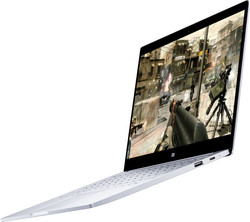
The Mi Notebook Air represents a successful debut for Xiaomi. Most decisive is that the manufacturer avoids big mistakes with the device. On the pro side, there is a very good display, a unibody case with excellent processing, a good cooling system (with one small restriction), good input devices and a laptop that offers power reserves immediately when needed - and it includes a dedicated Nvidia graphics card, almost a unique selling point in this market segment.
The negative points lie in the details: The device is missing an SD-card reader, unfortunately the display is glossy, and the case gets quite warm in load operation. The greatest disappointment is the battery: The Mi Notebook Air delivers at most average runtimes. Other manufacturers do much better regarding this point, for example, Dell with the XPS 13. Apart from that, prospective buyers should probably have a look at the upcoming Kaby Lake Ultrabooks, like HP's Spectre x360 and Lenovo's Yoga 910. Those are actually convertibles though, which might not appeal to everyone. Also, they are bigger and heavier than the XPS and the Mi Notebook Air.
Xiaomi's debut delivers good performance; the manufacturer did not make any big mistakes. Only the fact that it has to be imported could stand in the way of greater success.
Probably the best possible argument for the Mi Notebook Air is the price. All of the just-mentioned competitors are much more expensive. The Lenovo IdeaPad 710S in a similar price range could also be an interesting option.
Does the Mi Notebook Air get a recommendation? Yes, although it needs to be pointed out that it is not officially available in Germany. This leads to further difficulties like the American keyboard, the non-existent CE-label or the difficult warranty processing. Further information can be found in our article about "CE-labeling and Import". If Xiaomi officially put the Mi Notebook Air into the German market it would certainly be a successful device.
Xiaomi Mi Notebook Air 13.3 2016
- 10/15/2016 v5.1 (old)
Benjamin Herzig


